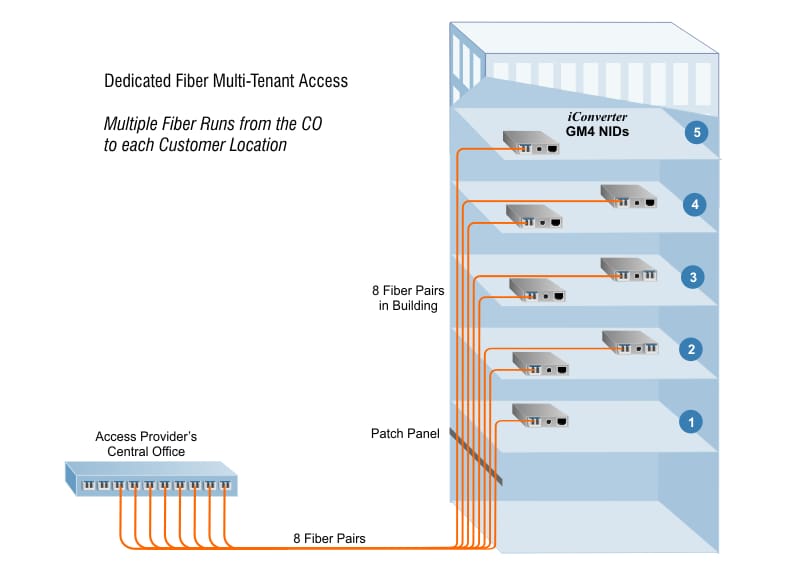Overview
Expand the capacity of multi-tenant building fiber access networks with CWDM
The bandwidth requirements of multi-tenant buildings are stretching the capacity of fiber optic access networks. Service Providers often run several fiber optic cables to multi-tenant buildings, tying up infrastructure that could be used to generate additional revenue. Coarse Wavelength Division Multiplexing (CWDM) technology enables Service Providers to expand the capacity of multi-tenant fiber access networks and deliver services to more subscribers.
CWDM transports multiple channels (wavelengths) over the same fiber cabling. Each channel carries data independently from each other, allowing network designers to transport different data rates and protocols (TDM, Ethernet, etc) for different customers or applications. CWDM supports up to 18 wavelengths, and each wavelength can transport up to 10G of data.
CWDM Products
CWDM Products
iConverter® CWDM Multiplexers/Demultiplexers

iConverter optical CWDM Multiplexer modules are part of the iConverter Multi-Service Platform and integrated with iConverter fiber transponders to deliver different services across a CWDM common link. iConverter CWDM MUX/DEMUX modules and Optical Add and Drop modules can be installed in a variety of compact and high-density chassis.
OmniLight® CWDM and DWDM Multiplexers/Demultiplexers

OmniLight passive CWDM and DWDM optical products provide a scalable, flexible and high-density solution for distributing wavelength services. OmniLight modules can be installed in a 14-Module LGX Chassis that supports 14 full-size LGX modules or 28 half-size LGX modules, or a 3-Module Rack-Mount Shelf that supports 3 full-size LGX modules or 6 half-size LGX modules.
>> Learn more about CWDM Multiplexers at the CWDM Resource Center
Muli-Tenant Fiber Access Application
CWDM Multi-Tenant Riser Fiber Access Network
In this application example, multiple fiber runs are transporting Carrier Ethernet business services to different customers in a multi-tenant building. The fiber runs are handed off from the service provider at the demarcation point (network equipment or a fiber patch panel) in the basement of the building, and then the fiber is run up the building to each customer location. The fiber in the building may be owned by the building management company, a riser management company, and there may be one or more service providers involved in delivering services.

iConverter GM4 NIDs are providing gigabit Carrier Ethernet service demarcation at each customer location in the building. iConverter XM5 NIDs can be deployed to deliver 10G services. The service provider has eight fiber pairs running from the Central Office across town to the building, which limits the scalability to add new customers in the building or along the fiber route to the building.

To expand the capacity of the access network, an iConverter 8-Channel CWDM/X Multiplexer is installed at Central Office. CWDM SFPs are installed in the CO switch, and each SFP has a unique CWDM wavelength that corresponds with the appropriate channel port on the CWDM/X Multiplexer. Patch cables connect each port on the switch to the CWDM MUX, illustrated with different colors for each wavelength.
One CWDM Common Fiber access link transports the eight CWDM channels (wavelengths) to the building. Each CWDM channel is an independent data transport of up to 10G per channel. Another 8-Channel MUX is installed in the basement of the building to de-multiplex the wavelengths. The CWDM channels are run up the fiber links in the building to each customer office (also color coded for each wavelength).
CWDM SFPs are installed in the iConverter GM4 NIDs at each customer location to convert the CWDM wavelengths to a copper RJ-45 connections or standard wavelength fiber for connectivity to customer equipment.
By deploying two iConverter 8-Channel CWDM/X Multiplexers and Omnitron’s CWDM SFPs, the service provider can repurpose the other seven fiber strands to add new customers along the fiber route or in the building, and generate additional revenue from the existing fiber plant.
Note that if each service is 10g, the service provider can transport 80G over the CWDM Common line.

This is a similar application, but the service provider does not own the demarcation equipment, so CWDM SFPs cannot be installed in the NIDs. The solution is to install the iConverter 8-Channel CWDM/X Multiplexers along with iConverter xFF Transponder modules in a 19-Module Chassis in the basement.
The xFF Transponder convert the CWDM channels to standard 850nm or 1310nm wavelengths, which are transported up the riser fiber with to the iConverter GM4 NIDs that use standard wavelength SFPs.










